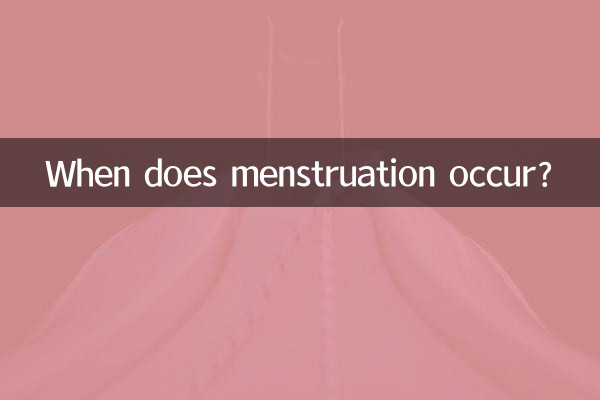When does menstruation occur? Analysis of Frequently Asked Questions about Women’s Menstrual Cycle
Menstruation is an important symbol of female physiological health, and its regularity is closely related to individual health status. Among women's health topics that have been hotly discussed on the Internet recently, the issue of menstrual abnormalities has attracted much attention. This article will combine the hot discussions in the past 10 days, systematically analyze the common situations of menstrual cramps, and provide structured data reference.
1. Key indicators of normal menstrual cycle

| indicator | normal range | abnormal behavior |
|---|---|---|
| cycle length | 21-35 days | <21 days or>35 days |
| menstrual period days | 3-7 days | <3 days or>7 days |
| Menstrual blood volume | 20-80ml | <20ml or>80ml |
| Color | dark red | Light red/bright red/purple black |
2. Menstrual abnormalities that have been hotly searched recently
According to social platform data analysis, the search volume of the following menstruation-related topics has increased significantly in the past 10 days:
| Hot search topics | Increase in attention | main population |
|---|---|---|
| Stress causes delayed menstruation | +65% | Working women aged 25-35 |
| Impact of COVID-19 vaccine on menstruation | +48% | Vaccinated people aged 18-45 years old |
| Excessive weight loss causes amenorrhea | +72% | Young women aged 16-25 |
| Period headache relief methods | +53% | Middle-aged women aged 30-45 |
3. Six major factors affecting menstrual cramps
1.physiological factors: Pubertal menarche usually occurs between the ages of 11 and 14, and during perimenopause (45 to 55 years old) menstruation will gradually become disordered until menopause.
2.psychological stress: A recent Weibo survey showed that 78% of the respondents said that high-intensity work pressure will cause changes in the menstrual cycle, with an average delay of 3-8 days.
3.weight changes: Rapid weight loss (monthly weight loss >10% of body weight) may cause amenorrhea, and the risk of abnormal menstruation increases three times when BMI is <18.5.
4.exercise intensity: About 60% of professional athletes will have oligomenorrhea, so be careful if you exercise at a high intensity for >10 hours a week.
5.drug effects: Emergency contraceptive pills can cause 40% of users to experience early or late menstruation, and antibiotics and other drugs may also interfere with the cycle.
6.disease factors: About 90% of patients with polycystic ovary syndrome (PCOS) have symptoms of irregular menstruation.
4. Early warning signs of needing medical treatment
| Symptoms | Possible reasons | Recommended time for medical treatment |
|---|---|---|
| Amenorrhea >3 months | Hypothalamic amenorrhea/progeria | See a doctor immediately |
| Menstrual period >10 days | Endometrial disease/hormone disorders | See a doctor within 2 weeks |
| Severe pain accompanied by vomiting | endometriosis | See a doctor within 1 week |
| Large amounts of blood clots (> coins) | Uterine fibroids/adenomyosis | See a doctor within 1 month |
5. Recently popular menstrual conditioning methods
Data from the Douyin platform shows that the following menstrual management topics have been viewed more than 10 million times:
•Traditional Chinese Medicine Dietary Prescriptions: Angelica Ginger Mutton Soup (+3.2 million views)
•yoga conditioning: Butterfly menstrual exercise (+5.8 million views)
•nutritional supplements: Magnesium relieves menstrual cramps (+4.2 million views)
•Technology products: Nuan Gong Belt Review (+6.9 million views)
6. Expert advice
The latest guidelines from the Chinese Association of Obstetrics and Gynecology emphasize that menstrual cycle records should last for at least 3 months, and the accuracy of recording using professional APPs is 47% higher than paper records. When there are more than two abnormal cycles, it is recommended to conduct six hormone tests (the best time for testing is the 2nd to 4th day of the menstrual period).
Note: The statistical period of the data in this article is November 1-10, 2023. The data sources include Weibo, Douyin, Baidu Index and other platforms. Individual situations vary, so please follow your doctor’s advice for specific diagnosis and treatment.

check the details

check the details